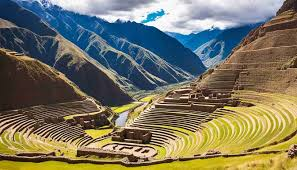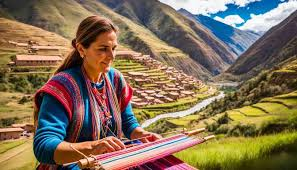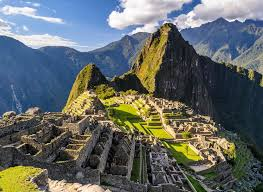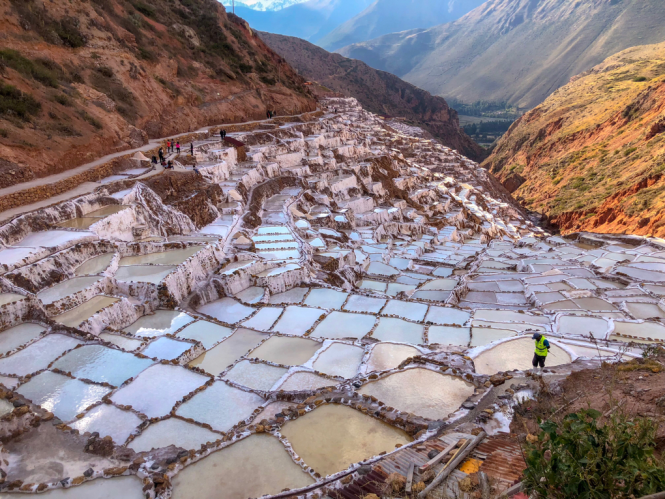Nestled between the towering Andes mountains, the Sacred Valley of Peru is a treasure trove of culture and history. This enchanting region is not just about breathtaking landscapes; it’s a living tapestry woven from ancient traditions that have thrived for centuries. As you journey through this vibrant valley, you’ll discover customs passed down through generations—each one telling its own unique story.
From the lush agricultural terraces that cling to steep hillsides to intricate textiles crafted by skilled hands, every facet of life here is colored by deep-rooted practices and beliefs. The Sacred Valley invites you to immerse yourself in its rich heritage, where every experience offers a glimpse into the heart and soul of Peruvian culture.

Get ready to explore seven remarkable treasures that define the Sacred Valley’s traditions—a celebration of community, creativity, and connection with nature awaits!
Table of Contents
Overview of Traditional Practices and Beliefs in Peru
The Sacred Valley of Peru is a vibrant tapestry woven from the threads of ancient traditions and beliefs. This region, once the heartland of the Inca Empire, continues to breathe life into its rich cultural heritage. The Sacred Valley is home to many indigenous communities, each with its own unique customs and practices that have been passed down through generations.
Traditional practices here are deeply rooted in respect for nature. Many local communities honor Pachamama, or Mother Earth, through rituals that express gratitude for her bounty. These ceremonies often involve offerings made at sacred sites.

Beliefs surrounding agriculture play a crucial role too. The people have mastered terracing techniques that not only boost crop yield but also reflect their profound understanding of sustainable farming.
In every village, stories passed down through generations celebrate ancestral wisdom and resilience. Artisans craft intricate textiles and pottery imbued with symbolic meanings linked to their history and environment. Each piece tells a story waiting to be discovered by those who visit this enchanting valley.
7 Treasures of the Sacred Valley’s Traditions:
The Sacred Valley of Peru is a vibrant tapestry woven from its rich traditions. Each treasure reflects the deep connection between the people and their land.
Agriculture thrives in this fertile valley, where ancient terracing techniques have sustained communities for centuries. The intricate designs not only showcase ingenuity but also respect for nature.

Handicrafts and textiles burst with color. Artisans create stunning pieces that tell stories of their heritage, using skills passed down through generations.
Culinary traditions offer more than just nourishment; they serve as a celebration of culture. Dishes are prepared with locally sourced ingredients, bringing families together around hearty meals.
Music and dance pulse through local festivals, embodying joy and community spirit. Rhythmic beats invite participation from everyone, transcending language barriers.
Healing practices rooted in medicinal plants highlight an intimate knowledge of nature’s gifts. These remedies reflect wisdom cultivated over time by indigenous healers.
Spiritual ceremonies connect the living to ancestral spirits, honoring nature’s cycles while fostering gratitude within the community.
Family values anchor these traditions firmly in daily life; cooperation and support form essential bonds among residents.
– Agriculture and Terracing
The Sacred Valley’s agriculture tells a story of resilience and innovation. The Incas mastered the art of terracing, transforming steep mountainsides into lush fields.
These terraces are more than just beautiful landscapes; they represent an ingenious response to the region’s challenging topography. Each level captures water efficiently, allowing crops to thrive despite harsh conditions.
Farmers cultivate native crops like quinoa, potatoes, and corn here. These staples not only sustain local diets but also preserve centuries-old agricultural practices.
Visitors can witness traditional farming techniques during harvest festivals. The vibrant colors of fresh produce highlight both biodiversity and cultural pride.
Engaging with local farmers offers insights into their deep connection with the land. Their knowledge is passed down through generations, ensuring that ancient wisdom remains alive in modern times.
– Handicrafts and Textiles
Handicrafts and textiles in the Sacred Valley are vibrant expressions of cultural heritage. Artisans skillfully weave intricate patterns into colorful fabrics, showcasing techniques passed down through generations.
Each piece tells a story, often reflecting local flora and fauna or ancient myths. The use of natural dyes derived from plants lends a unique touch to these creations, ensuring every item is distinct.
You’ll find everything from intricately designed blankets to stylish bags that carry the essence of the Andes. These textiles aren’t just for show; they play essential roles in daily life and traditional festivals.
Visiting local markets offers an immersive experience where you can meet artisans dedicated to preserving their craft. Purchasing these handmade items directly supports their communities and keeps these traditions alive for future generations.
– Culinary Traditions
Culinary traditions in the Sacred Valley of Peru are a vibrant tapestry of flavors and techniques. Each dish tells a story, connecting generations through age-old recipes.
Local ingredients play a crucial role. Potatoes, corn, and quinoa are staples that flourish in this fertile region. Farmers take pride in their harvest, which reflects centuries of agricultural wisdom.
Street markets buzz with activity, showcasing colorful fruits and vegetables alongside traditional foods like “cuy” (guinea pig) and “pachamanca.” Cooking methods often involve earth ovens or simple clay pots—methods passed down over time.
Festivals bring communities together to celebrate food. Dishes prepared during these events embody not just sustenance but also cultural identity.
Dining is an experience here; it’s about sharing stories around the table. Each meal fosters connection among family members while honoring their rich heritage and traditions.
– Music and Dance
Music and dance pulse at the heart of Sacred Valley’s traditions. They are not merely forms of entertainment; they tell stories woven into the fabric of daily life.
The vibrant sounds of pan flutes, charangos, and drums resonate through the valleys. Each instrument carries a history that connects generations, echoing ancient rituals and celebrations.
Dance complements this melody beautifully. Traditional dances like the “Marinera” capture romance and community spirit in graceful movements. Festivals come alive with colorful costumes that reflect cultural heritage.
During special occasions, locals gather to perform these time-honored dances under starry skies or in village plazas. The energy is contagious as everyone joins in—young children learn from their elders while reinforcing bonds within families.
These artistic expressions serve as a reminder of identity, resilience, and joy amid challenges faced by communities over centuries. In every note played or step taken lies an invitation to share in Peru’s rich tapestry of culture.
– Healing and Medicinal Plants
The Sacred Valley is a treasure trove of healing and medicinal plants, deeply woven into the fabric of local traditions. Indigenous communities have long relied on nature’s pharmacy to treat ailments and promote well-being.
One standout is the maca root, known for its invigorating properties. This adaptogenic superfood enhances energy levels and supports hormonal balance.
Another significant plant is muña, often used in herbal teas for respiratory issues. Its aromatic leaves not only soothe but also carry rich cultural significance as a symbol of wellness.
Shamanic practices further amplify these benefits. Shamans guide healing ceremonies using plant wisdom passed down through generations. They create potent brews that connect individuals with their physical and spiritual health.
Visitors to the Sacred Valley can immerse themselves in this botanical world by learning about traditional uses or participating in workshops led by skilled healers who share their knowledge with respect and reverence.
– Spiritual Ceremonies and Rituals
Spiritual ceremonies and rituals form the heart of life in the Sacred Valley. They connect communities to their ancestors and the natural world, creating a rich tapestry of beliefs and practices.
One prominent ceremony is Inti Raymi, an ancient festival honoring the Sun God. Locals don colorful costumes and reenact traditional rites that date back to Incan times. It’s a vibrant celebration filled with music, dance, and offerings.
Another important ritual involves Pachamama, or Mother Earth. Each August, families offer food and coca leaves to express gratitude for her blessings. This deep respect for nature fosters a strong sense of community connection.
Communities also participate in smaller ceremonies tied to agriculture. Planting seeds often includes prayers for fertility while harvesting may involve celebrations that thank deities for bountiful crops. These practices keep traditions alive while nurturing spiritual connections within daily life.
– Community and Family Values
In the Sacred Valley, community and family are at the heart of daily life. Relationships form a vibrant tapestry woven from shared experiences, celebrations, and challenges.
Families often gather for traditional meals, where recipes passed down through generations create bonds over food. These gatherings foster unity and pride in their heritage.
Community events play a vital role too. Locals come together to celebrate festivals that honor ancient customs while reinforcing social ties. Each celebration is an opportunity to share joy and strengthen connections.
Support among neighbors is paramount; people lend a hand during harvest or construction projects without hesitation. This spirit of cooperation not only enriches individual lives but also fortifies the cultural fabric of the valley.
Respect for elders remains deeply ingrained in their values as they serve as custodians of wisdom and traditions, guiding younger generations with stories that keep history alive within families.
Impact of Tourism on Tradition in the Sacred Valley
Tourism has transformed the Sacred Valley, drawing visitors from around the globe. This influx brings opportunities but also challenges.
Local artisans showcase their crafts to a wider audience. Yet, as demand grows, some traditional methods risk fading away. Authenticity can sometimes give way to mass production, altering the very essence of these unique practices.
On the flip side, tourism encourages cultural exchange and awareness. Travelers often engage with local customs and beliefs, fostering appreciation for Peru’s rich heritage.
Communities are more interconnected than ever due to shared experiences with visitors. However, this connection must be navigated carefully so that traditions remain genuine while benefiting from new influences.
Sustainable tourism initiatives emerge in response to these dynamics. They aim to strike a balance between preservation and progress in the Sacred Valley’s enchanting landscape.
How to Respect and Support Local Customs
When visiting the Sacred Valley, embracing local customs is paramount. Begin by learning a few words of Quechua or Spanish. This small gesture can open doors and create genuine connections.
Support artisans by purchasing handmade crafts directly from them. This ensures that your money goes back into the community and helps preserve traditional techniques.
Participating in workshops offers an immersive experience. You’ll gain insights into their artistry while fostering respectful relationships with locals.
Respect cultural sites by following guidelines and showing appreciation for their significance. Avoid disruptive behaviors during ceremonies or rituals to honor their traditions.
Consider eco-friendly accommodations that prioritize sustainability. Such choices reflect your commitment to preserving both culture and environment for future generations in Peru’s enchanting Sacred Valley.
Conclusion
Experiencing the Sacred Valley offers a unique glimpse into the rich tapestry of Peru’s cultural heritage. The 7 treasures of the Sacred Valley’s traditions provide not only a connection to ancient practices but also an appreciation for contemporary life in this vibrant region. From awe-inspiring agricultural techniques that have nurtured generations, to intricate handicrafts and culinary delights that tell stories of their own, each aspect reveals the resilience and creativity of its people.
As you immerse yourself in music, dance, and spiritual ceremonies, you’ll find an inviting community deeply rooted in family values and collective support. This dynamic environment thrives on respect for tradition while adapting to modern influences.
Tourism plays a vital role in sustaining these traditions, but it comes with responsibilities. Supporting local artisans and participating mindfully in cultural experiences can help preserve what makes this area so special. Every visit is an opportunity not just to witness but also to honor the living culture of Peru’s Sacred Valley.
Embrace the chance to learn from those who call this enchanting place home; it’s an experience that will stay with you long after you leave its breathtaking landscapes behind.
Click here for related details.
Stay tuned on Travelyas for insight details.

